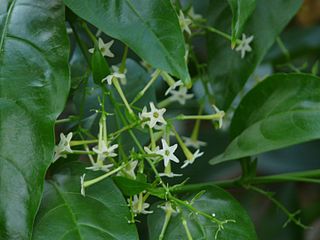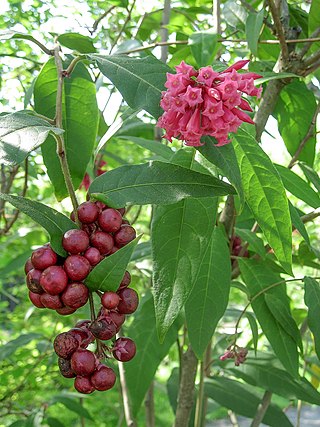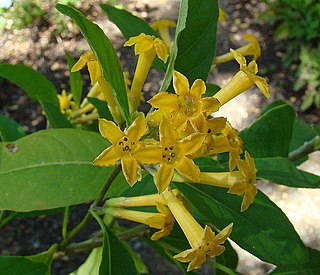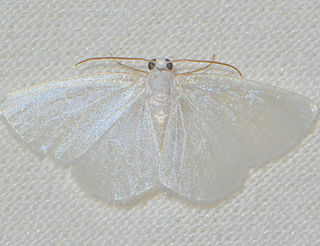Queen of the Night may refer to:

Cestrum nocturnum, the lady of the night, night-blooming jasmine, night-blooming jessamine, night-scented jessamine, night-scented cestrum or poisonberry, is a species of plant in the potato family Solanaceae. It is native to the West Indies, but naturalized in South Asia.

Cestrum is a genus of — depending on authority — 150-250 species of flowering plants in the family Solanaceae. They are native to warm temperate to tropical regions of the Americas, from the southernmost United States south to the Bío-Bío Region in central Chile. They are colloquially known as cestrums or jessamines.

Cestrum aurantiacum is native to North and South America. This plant is used as an ornamental plant, and it is a poisonous plant if eaten by animals. It is regarded as medicinal in Peru.

Sessea is a genus of 19 accepted species of shrubs, small trees and climbers belonging to the subfamily Cestroideae of the plant family Solanaceae. The flowers of Sessea are so similar to those of Cestrum that the genera cannot usually be told apart, unless the plants are in fruit. Then their distinguishing characteristics become immediately apparent; plants of the genus Sessea bearing dehiscent capsules dispersing winged seeds, while those belonging to the genus Cestrum bear juicy berries containing prismatic seeds. The flowers of both Sessea and Cestrum have tubular corollas that are long exserted from small calyces.

Cestrum parqui, commonly known as palqui, green cestrum, Chilean cestrum, green poisonberry, or willow-leaved jessamine, is a species of flowering plant native to Chile.

Cestrum fasciculatum is a species of flowering plant in the family Solanaceae known by the common names early jessamine and red cestrum. It is native to central Mexico, but it is also kept elsewhere as an ornamental plant. This is a gangly evergreen shrub reaching a maximum height of over two meters. The stems, and especially new twigs, are sometimes purple in color and slightly hairy. It bears hairy, oval-shaped, pointed green leaves up to 13 centimeters long. Plentiful inflorescences appear at the tips of stem branches, each a dense cluster of up to 10 hairy red flowers. Each tubular flower is 2 or 3 centimeters long, counting the elongated calyx of sepals and the long corolla. The fruit is a berry about 1.5 centimeters wide which is red on the outside and white inside with about 10 small brown seeds.

Iochroma arborescens is a species of flowering plant in the genus Iochroma, belonging to the nightshade family Solanaceae. Formerly it was considered the single species in the monotypic genus Acnistus. Common names include gallinero, mata-gallina, fruta-de-sabiá, hollowheart, wild tobacco, siyou, bastard sirio, galán arbóreo, tabaco de monte, nigüito, marieneira, güitite, and tabak djab.

Eduard August von Regel was a German horticulturalist and botanist. He ended his career serving as the Director of the Russian Imperial Botanical Garden of St. Petersburg. As a result of naturalists and explorers sending back biological collections, Regel was able to describe and name many previously unknown species from frontiers around the world.

Cestrum diurnum is a species of Cestrum, native to the West Indies. Common names include day-blooming cestrum, day-blooming jessamine, and day-blooming jasmine. Also known as Din ka Raja, in Urdu and Hindi. The scent of this quick-growing and evergreen woody shrub, often used for screens and borders, is released by day. Cestrum diurnum is easily propagated from the seed, which it produces in abundance.
Vepridaphne cestrum is a species of sea snail, a marine gastropod mollusk in the family Raphitomidae.
Vepridaphne is a genus of sea snails, marine gastropod mollusks in the family Raphitomidae.

Cestrum elegans, the purple cestrum, red cestrum, or bastard jasmine, is a species of flowering plants in the genus Cestrum.

Vestia is a monotypic genus of flowering plants in the family Solanaceae containing the single species Vestia foetida (syn. V. lycioides). Its principal common names in the Mapudungun language of its native Chile are Huevil (pron. "wayfil" and sometimes redoubled Huevilhuevil) and Chuplín. Other Chilean names include Chuplí, Echuelcún and Palqui (negro) (this last being also applied to Cestrum parqui), while an English common name Chilean box thorn has also been coined recently in reference to a certain similarity of the plant to some species in the box thorn / wolfberry genus Lycium (as referenced also in the former specific name lycioides, meaning "Lycium-like"). Vestia foetida is endemic to central and southern Chile, being found in an area stretching from the Valparaíso Region in the north to Chiloé Island (in the Los Lagos Region) in the south. Growing to 2 m (7 ft) tall by 1.5 m (5 ft) broad, it is an evergreen shrub with glossy, privet-like, mid-green leaves. In spring and summer it bears tubular yellow flowers to 3 cm (1 in) long, with stamens so markedly exserted (= protruding) as to recall those of certain Fuchsia species, followed by 4-valved, ovoid capsules to 1 cm (0 in), containing small, prismatic seeds.

Lomographa vestaliata, Also known as white spring moth or Spring faerie, is a moth in the family Geometridae. The species was first described by Achille Guenée in 1857. Adults are diurnal and on wing in spring, usually found around the cestrum nocturnum tree, pollinating their flowers
Lycée Jules Verne (LJV) is a French international school in South Africa. The main campus is in Sandton, Johannesburg, while the Pretoria Campus is in Arcadia, Pretoria. It is a part of the Agency for French Education Abroad (AEFE). It covers levels pre-primary until high school.
Soymovirus is a genus of viruses, in the family Caulimoviridae order Ortervirales. Plants serve as natural hosts. There are four species in this genus.

Cestroideae is a subfamily of the plant family Solanaceae, the nightshades.
Queen Empress was an American National Champion Thoroughbred racemare bred and raced by the Wheatley Stable of Gladys Mills Phipps and her brother, Ogden Livingston Mills.











